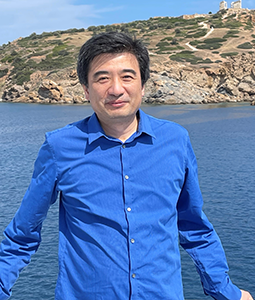School of Medicine Columbia
- SC.edu
- Study
- Colleges and Schools
- School of Medicine Columbia
- About
- Faculty and Staff
- Wenbin Tan Ph.D.
Faculty and Staff
Wenbin Tan, Ph.D.
| Title: | Associate Professor |
| Department: | Department of Cell Biology and Anatomy School of Medicine Columbia |
| Email: | Wenbin.Tan@uscmed.sc.edu |
| Phone: | 803-216-3816 |
| Resources: | Tan's Lab Website |

Education
B.S.: Central South University, Xiangya School of Medicine, P. R. China
M.S., Biochemistry and Molecular Biology: Central South University, Xiangya School of Medicine, P. R. China
Ph.D., Neurophysiology and Neurobiology: University of California, Los Angeles (UCLA)
Research
Dr. Tan’s lab is interested in stem cell biology, vascular ageing, congenital vascular malformations, exosomal biology, and therapeutic benefits of natural compounds. His lab has developed disease-derived iPSCs and iPSC-induced vascular cells and organoids as clinically relevant models to understand the fundamental mechanisms of vascular related diseases and endothelial dysfunctions. The current ongoing research projects include (1) generating disease-derived iPSCs for mechanistic and therapeutic development studies. The diseases include capillary malformations (CM), Sturge-Weber syndrome (SWS), hypertension, and other vascular disorders. (2) reprogramming of hypertensive ECs for rejuvenating hypertensive ECs for treatment; (3) developing novel types of therapeutic strategies for targeting of lesional endothelial cells (ECs) with or without a combination of laser-based technology; (4) the role of exosomes in endothelial dysfunction; and (5) cardiovascular complications associated with chronic inflammation and innate functions of natural compounds for vascular benefits.
The research projects have been continuously supported by numerous awards from ASLSM, NIH, and DoD since 2012.
Biography
Dr. Tan is an Associate Professor in the Department of Cell Biology and Anatomy at the School of Medicine Columbia. He is also affiliated with the Cardiovascular Research Center and the Department of Bioengineering at USC.
He obtained his B.Sc. in Medicine and M.Sc. in Biochemistry and Molecular Biology at the Xiangya School of Medicine, Central South University, China. He received his Ph.D. in Neurophysiology and Neurobiology at the University of California, Los Angeles, USA, in 2008 under the mentorship of Dr. Jack L. Feldman.
His Ph.D. dissertation was to study rhythmic neurons in the brainstem for neuronal control of breathing. In 2010, his family moved to Anaheim, Orange County where Disneyland is located. Then he joined Dr. J Stuart Nelson’s group in the Department of Surgery and the Beckman Laser Institute at the University of California, Irvine, where he began his research in congenital vascular malformations. This was a radical and involuntary transition for his research from neurons to endothelial cells.
When he was weighing academic continuation or industrial opportunity as the next step of his career, he received an NIH/NIAMS K01 in 2013 with a perfect score (zero) on the first time of submission. This award kept him in academia. He had been deeply indebted to Dr. J Stuart Nelson and Dr. Dongbao Chen at UC Irvine for their mentorships. He received an R01 and a DoD discovery award in 2018 and made his cross-continental journey to the School of Medicine University of South Carolina.
He continues to miss a variety of authentic foods and no-change-cool weather in Southern California but not the torturous traffic on the 405/105/5/10/91/22 highways. He has been enjoying the beautiful natural environment in South Carolina.
Publications
Pernomian L, Waigi EW, Nguyen V, Mohammed AD, da Costa TJ, Fontes MT, Kubinak JL, Aitken A, Biancardi VC, Sinclair DA, McCarthy CG, Wang Y, Tan W, Wenceslau CF. A Single-Short Partial Reprogramming of the Endothelial Cells decreases Blood Pressure via attenuation of EndMT in Hypertensive Mice. Circ Res, 2025 Aug, accepted.
Gao C, Nguyen V, Hochman ML, Gao L, Chen EH, Friedman HI, Nelson JS, Tan W. Current clinical evidence is insufficient to support HMME-PDT as the first choice of treatment for young children with port wine birthmarks. Lasers Surg Med. 2024 Apr;56(4):321-333. doi: 10.1002/lsm.23779. PMID: 38506454. 3. Nguyen V, Taine EG, Meng D, Cui T, Tan W. Chlorogenic Acid: A Systematic Review on the Biological Functions, Mechanistic Actions, and Therapeutic Potentials. Nutrients. 2024 Mar 23;16(7). doi: 10.3390/nu16070924. PMID: 38612964; PMC11013850. 4. Nguyen V, Taine EG, Meng D, Cui T, Tan W. Pharmacological Activities, Therapeutic Effects, and Mechanistic Actions of Trigonelline. Int J Mol Sci. 2024 Mar 16;25(6). doi: 10.3390/ijms25063385. Review. PMID: 38542359; PMC10970276.
Nguyen V, Gao C, Hochman ML, Kravitz J, Chen EH, Friedman HI, Wenceslau CF, Chen D, Wang Y, Nelson JS, Jegga AG, Tan W. Endothelial cells differentiated from patient dermal fibroblast-derived induced pluripotent stem cells resemble vascular malformations of port-wine birthmark. Br J Dermatol. 2023 Nov 16;189(6):780-783. doi: 10.1093/bjd/ljad330. PMID: 37672656; PMC10653332. Supporting materials: bioRxiv. 2023 Aug 24;. doi: 10.1101/2023.07.02.547408. PMID: 37662218; PMC10473620.